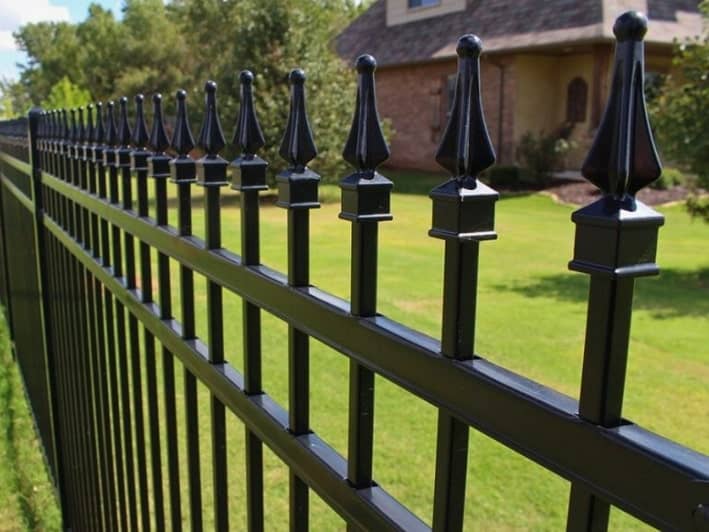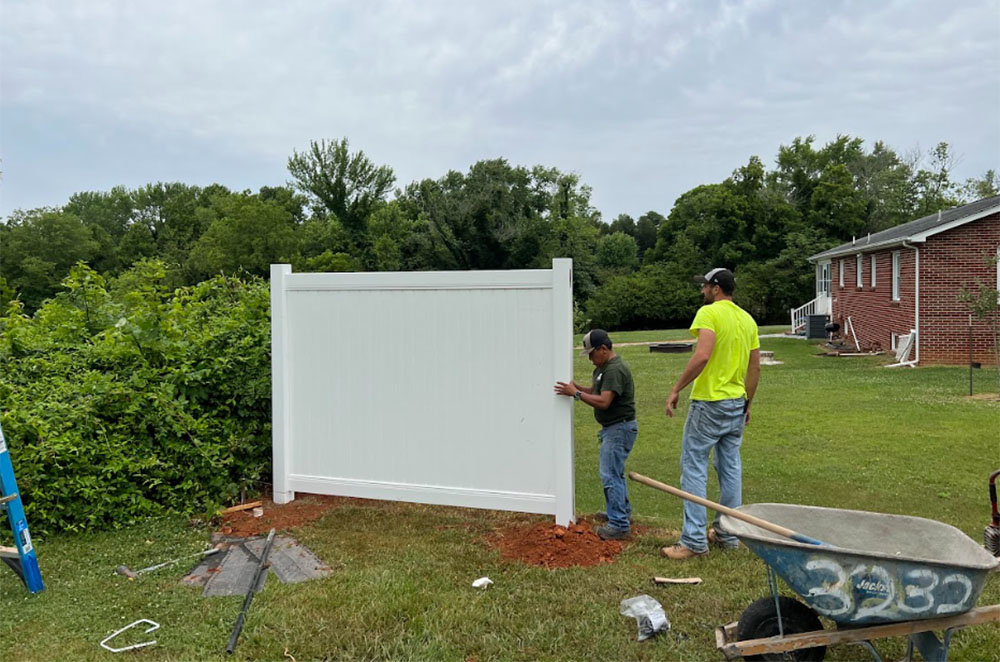Reasons of Working with an Qualified Fence Contractor
Exactly How to Recognize Typical Concerns That Call For Immediate Fencing Repair Work
It is vital to identify problems prior to they end up being bigger issues when it comes to keeping your fence. Routinely looking for indications of decaying timber, leaning panels, or corrosion can save you money and time in the long run. You may not recognize exactly how climate and parasites can jeopardize your fence's integrity. Let's check out the typical indicators that indicate your fence requires prompt interest, so you can maintain your building safe and looking its finest.
Signs of Rotting Timber in Wooden Fences
Have you seen your wood fence looking a bit shabby? It could be time to check for indicators of decaying timber if so. Analyze the base of the blog posts and panels for soft spots. If you continue the wood and it feels spongy or falls apart, that's a clear indication of rot. Next off, try to find discoloration or dark areas on the timber-- these usually signal moisture damage. Focus on any type of peeling paint or coating, as this can reveal the wood to more decay. Additionally, a poignant, musty smell can show fungal development. Don't neglect to check joints and connections; if they hang or falling apart, the timber beneath is likely compromised. By capturing these indicators early, you can stop more comprehensive damages and keep your fence standing strong. Regular maintenance is essential to expanding the life of your wooden fencing.
Leaning or Tilting Fence Panels
It's essential to recognize what created it if you have actually noticed your fencing panels tilting or leaning. This concern might show underlying architectural damages that needs your attention. Let's discover the usual causes and the repair work choices readily available to get your fencing back in form.

Reasons of Leaning Panels
It's often a sign of underlying issues that require attending to when you notice your fence panels leaning or tilting. One usual cause is poor drainage; extreme water can deteriorate the dirt around the fencing messages, compromising their assistance. Another wrongdoer might be strong winds or storms that push against the panels, specifically if they're not appropriately anchored. Additionally, the natural settling of soil gradually can create posts to change, leading to a tilt. Bugs, like termites, can endanger the honesty of wooden panels, triggering them to lean. Ultimately, poor setup methods might result in panels not being safely set, leaving them prone to leaning under pressure. Address these issues immediately to maintain your fencing's stability.
Indications of Architectural Damages
Seeing turning or leaning fencing panels can be alarming, as these concerns commonly show structural damages that requires prompt attention. When your fence begins to lean, it may signify that the posts are changing or that the dirt around them has actually worn down. Pay attention to voids between messages or panels, as these can also recommend instability. deck builder. In addition, look for splits or splintering in the wood, which can compromise the overall structure. It can compromise the honesty of the fence if you observe corrosion or corrosion on metal parts. Bear in mind, neglecting these indicators can bring about much more serious damage down the line, so it's vital to analyze the situation quickly and act before it intensifies
Fixing Options Available

Rust and Corrosion in Metal Fences
If you have a metal fence, you may discover rust and deterioration creeping in over time, specifically if it's revealed to moisture. These concerns not only affect the look of your fencing but can also compromise its structural stability. To identify corrosion, look for reddish-brown areas or patches, which suggest the metal is oxidizing. Deterioration can spread out promptly if left neglected, leading and compromising the fence to expensive repairs.To tackle corrosion and corrosion, you should clean up the impacted areas with a cable brush and use a rust-inhibiting primer. Once the guide dries out, take into consideration painting the fence with a weather-resistant paint to shield it further. Routine maintenance, such as evaluating for indications of rust and touching up paint as required, will certainly assist extend your fence's lifespan. Resolving these concerns quickly assures your steel fence remains strong and visually appealing for years to come.
Cracks and Divides in Vinyl Secure Fencing

Sources Of Vinyl Damage
Plastic secure fencing is preferred for its durability, yet it can still struggle click here for more with cracks and divides because of numerous elements. One significant reason is extreme temperature fluctuations. It can deteriorate the material over time when vinyl broadens in the warmth and agreements in the cool. In addition, exposure to harsh sunlight can cause UV deterioration, making the vinyl brittle. Physical influences, like unexpected collisions or hefty branches, can likewise develop splits. Poor setup or utilizing low-quality materials can exacerbate these issues. Age plays a duty; older vinyl secure fencing is more prone to damages. Normal evaluations can help you recognize these factors prior to they cause substantial problems. Take positive measures to assure your fencing stays intact and strong.
Repairing Cracks Effectively
Although splits and splits in your vinyl fence can be worrying, addressing them quickly can stop additional damages and keep the fence's look. First, examine the dimension of the crack. For little fractures, a vinyl repair package typically includes sticky that can bond the edges, providing a seamless fix. Tidy the location completely before using the glue, ensuring it adheres appropriately. For bigger divides, you may require to utilize a vinyl spot. Cut the patch to size, use adhesive around the edges, and press it securely onto the split. Allow it to heal as per the maker's instructions. Regular upkeep and quick repair work can prolong your fencing's life-span, keeping it looking fantastic for many years ahead.
Loose or Missing Out On Fencing Posts
Missing or loosened fence blog posts can weaken the security of your whole fencing framework. It's crucial to deal with the issue instantly if you see any messages leaning or tottering. Look for any kind of signs of activity, as this can cause additional damages gradually. You can easily examine the problem by providing each message a gentle shake-- if it really feels unpredictable, it's time to take action.For missing out on posts, you'll require to replace them as quickly as possible to keep your fencing's stability. When you set up brand-new blog posts, make sure they're firmly anchored in the ground with concrete or gravel for included security. If a blog post is loose, tighten it by including additional support or driving it deeper right into the ground.Ignoring these issues can result in bigger troubles, like gaps in your fence or even total collapse. Maintain an eye on your articles and remain aggressive about repair work!
Damages From Weather and Natural Aspects
Weather condition and natural environments can ruin your fencing, resulting in numerous types of damage that require punctual interest. Hefty rain can trigger timber to rot, making it unsteady and weak. Snow build-up could flex or damage panels, while solid winds can root out fencing blog posts or create areas to lean.If you notice splits or splintering in wooden fencings, it's an indication of drying out because of extreme sun exposure. Steel fences can corrosion if safety finishings use off, especially in moist or seaside areas.Inspect your fence on a regular basis after tornados or extreme weather to catch any damages early. Attending to these concerns promptly can conserve you from pricey repairs down the line. Don't wait till a tiny trouble transforms into a major one; stay proactive and keep your surround leading form to keep both capability and curb appeal.
Insect Invasion and Termite Damage
It's vital to act swiftly to avoid further damage when you notice signs of insect infestation or termite damages. Look for mud tubes along your fencing or hollow-sounding wood, as these show termites go to work. You could likewise see little openings or frass, which is termite droppings appearing like sawdust. If you spot any of these indicators, it's time to assess the damage.Don' t wait up until it's far too late; bugs can jeopardize your fencing's stability. Check the surrounding location for ants or beetles, as they may be adding to the trouble. If you believe a problem, think about calling an insect control professional to treat the issue.repairing and verify or changing damaged areas of your fencing promptly not just recovers its stamina but likewise stops bugs from spreading even more. Remain cautious to maintain your residential property pest-free and secure.
Regularly Asked Questions
Just how Typically Should I Check My Fence for Damages?
You need to inspect your fence at the very least twice a year, preferably during springtime and fall. Regular checks aid you find damages early, saving you money and time on repairs while maintaining your home's appearance and safety.
Can I Fix a Fencing Myself or Employ a Professional?
If you have the right devices and skills, you can definitely repair a fencing on your own. Nevertheless, employing an expert guarantees top quality job and saves you time, specifically for intricate repairs or extensive damage.
What Devices Are Required for Basic Fencing Repairs?
For standard fence repair check that services, you'll need tools like a hammer, screwdriver, pliers, a saw, a level, and determining tape. deck builder. Relying on the repair, you visit our website could additionally need nails, screws, or replacement boards
Just How Much Does Fence Repair Typically Price?
Fencing fixing prices vary commonly, however you can anticipate to pay between $200 and $1,500 depending on products, labor, and level of damage. It's smart to get numerous quotes for the finest deal.
When Is the Best Time of Year for Fencing Repair Works?
The best time for fencing repairs is during moderate weather condition, normally in springtime or early fall. You'll stay clear of extreme temperatures, making it easier to function and making certain the products established effectively for lasting durability (deck builder). Discovering tilting or leaning fence panels can be startling, as these issues frequently suggest structural damage that requires instant attention. Loose or missing fencing posts can threaten the security of your entire fencing framework. Snow accumulation may flex or break panels, while strong winds can root out fencing posts or trigger sections to lean.If you observe splits or splintering in wooden fences, it's an indication of drying out due to intense sun direct exposure. Metal fences can rust if protective finishings put on off, specifically in damp or seaside areas.Inspect your fencing frequently after tornados or extreme weather to catch any damages early. Fencing fixing costs vary extensively, but you can anticipate to pay in between $200 and $1,500 depending on products, labor, and level of damage